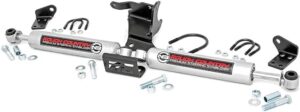Jeep Death Wobble – Explanation And How To Fix
Unraveling the Mystery Behind Jeep Death Wobble
Jeep Death Wobble
Jeep Death Wobble – two words that strike fear into the hearts of Jeep owners and off-road enthusiasts alike. But what exactly is the infamous Death Wobble, and why does it happen? In this comprehensive guide, we’ll delve into the causes, symptoms, and solutions to help you understand and overcome this notorious phenomenon.
Understanding the Death Wobble
The Death Wobble is a frightening experience characterized by violent shaking or oscillations in the front end of a Jeep, typically occurring at high speeds or after hitting a bump or pothole. While it primarily affects Jeep Wranglers, it can also occur in other Jeep models and vehicles with solid front axles.
Causes of Jeep Death Wobble
Several factors can contribute to the occurrence of Death Wobble, including:
- Worn Suspension Components: Aging or worn-out suspension components such as ball joints, control arms, tie rod ends, and track bars can contribute to instability and wobbling.
- Imbalanced or Misaligned Tires: Uneven tire wear, imbalanced tires, or improper tire alignment can lead to vibrations and oscillations, exacerbating the Death Wobble.
- Loose Steering Components: Loose or worn steering components, including the steering stabilizer, drag link, and steering box, can cause instability and contribute to the onset of Death Wobble.
- Lift Kits and Modifications: Improperly installed lift kits or aftermarket modifications that alter the vehicle’s geometry can disrupt the suspension’s dynamics and increase the likelihood of Death Wobble.
Symptoms of Death Wobble
Recognizing the symptoms of Death Wobble is crucial for addressing the issue promptly. Common signs include:
- Sudden and violent shaking of the steering wheel
- Front end oscillations or vibrations, especially at high speeds
- Difficulty maintaining control of the vehicle
- Audible noises such as clunking or banging from the front end

Solutions and Prevention
Preventing and mitigating Death Wobble requires a systematic approach and thorough inspection of the vehicle’s components. Here are some steps to address the issue:
- Inspect and Replace Worn Components: Regularly inspect and replace worn suspension components to maintain optimal performance and stability.
- Ensure Proper Tire Maintenance: Maintain proper tire pressure, rotate tires regularly, and ensure proper wheel balancing and alignment to prevent uneven wear and vibrations.
- Check Steering Components: Inspect and tighten all steering components, including the steering stabilizer, drag link, and tie rod ends, to eliminate play and instability.
- Address Lift Kit Installation: If your Jeep is equipped with a lift kit, ensure that it is installed correctly and that all modifications adhere to manufacturer guidelines and recommendations.
Tackling the Death Wobble Head-On
While the Jeep Death Wobble may be a daunting and unnerving experience, understanding its causes, symptoms, and solutions can empower Jeep owners to address the issue effectively. By prioritizing regular maintenance, inspecting critical components, and adhering to proper installation practices, you can minimize the risk of Death Wobble and enjoy a safer and more enjoyable off-road experience in your Jeep.
Whether you’re a seasoned off-road enthusiast or a Jeep owner new to the world of off-roading, tackling the Death Wobble head-on is essential for maintaining your vehicle’s performance, safety, and reliability. With the insights and strategies outlined in this guide, you can navigate through the challenges of Death Wobble and embark on your Jeep off-road adventures with confidence and peace of mind.
In most cases your Jeep Powertrain Warranty will cover the replacement of your steering stabilizer. This is if the Stabilizer is stock and the tires are not larger than the recommended size.
Consider An Official Jeep Extended Warranty from Chrysler-Factory-Warranty.
Learn More












